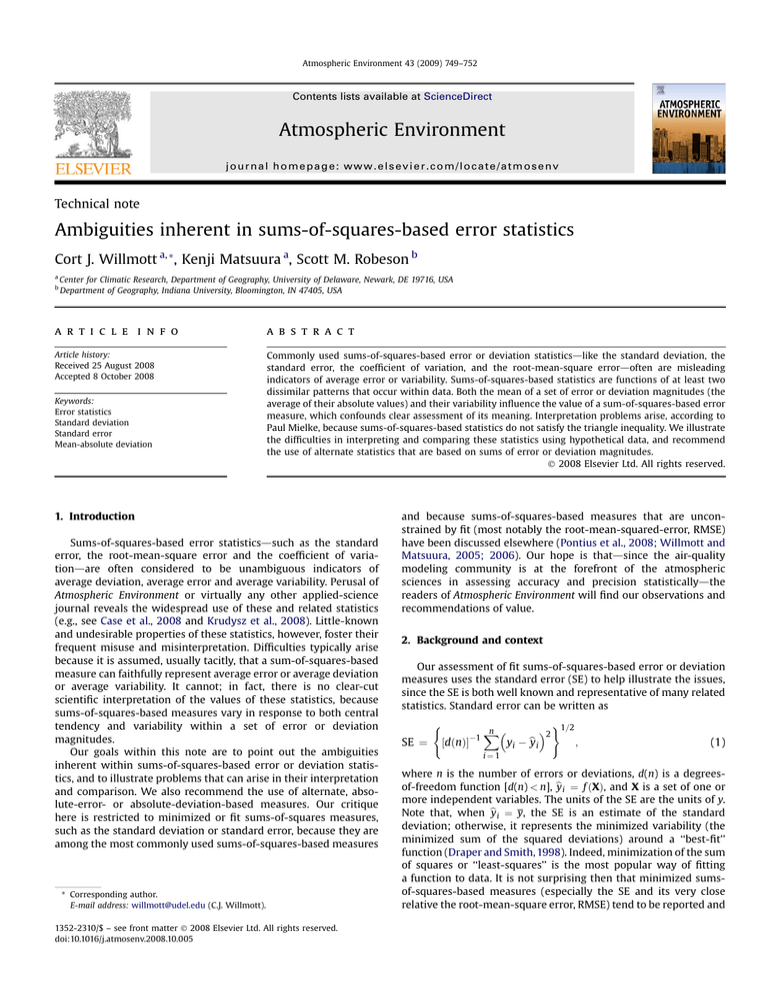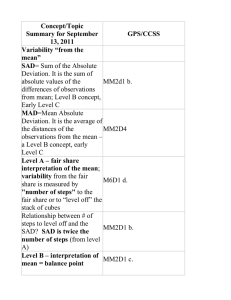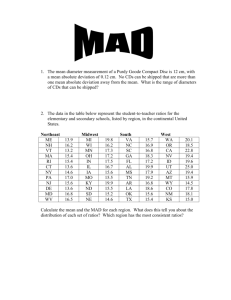
Atmospheric Environment 43 (2009) 749–752
Contents lists available at ScienceDirect
Atmospheric Environment
journal homepage: www.elsevier.com/locate/atmosenv
Technical note
Ambiguities inherent in sums-of-squares-based error statistics
Cort J. Willmott a, *, Kenji Matsuura a, Scott M. Robeson b
a
b
Center for Climatic Research, Department of Geography, University of Delaware, Newark, DE 19716, USA
Department of Geography, Indiana University, Bloomington, IN 47405, USA
a r t i c l e i n f o
a b s t r a c t
Article history:
Received 25 August 2008
Accepted 8 October 2008
Commonly used sums-of-squares-based error or deviation statisticsdlike the standard deviation, the
standard error, the coefficient of variation, and the root-mean-square errordoften are misleading
indicators of average error or variability. Sums-of-squares-based statistics are functions of at least two
dissimilar patterns that occur within data. Both the mean of a set of error or deviation magnitudes (the
average of their absolute values) and their variability influence the value of a sum-of-squares-based error
measure, which confounds clear assessment of its meaning. Interpretation problems arise, according to
Paul Mielke, because sums-of-squares-based statistics do not satisfy the triangle inequality. We illustrate
the difficulties in interpreting and comparing these statistics using hypothetical data, and recommend
the use of alternate statistics that are based on sums of error or deviation magnitudes.
Ó 2008 Elsevier Ltd. All rights reserved.
Keywords:
Error statistics
Standard deviation
Standard error
Mean-absolute deviation
1. Introduction
Sums-of-squares-based error statisticsdsuch as the standard
error, the root-mean-square error and the coefficient of variationdare often considered to be unambiguous indicators of
average deviation, average error and average variability. Perusal of
Atmospheric Environment or virtually any other applied-science
journal reveals the widespread use of these and related statistics
(e.g., see Case et al., 2008 and Krudysz et al., 2008). Little-known
and undesirable properties of these statistics, however, foster their
frequent misuse and misinterpretation. Difficulties typically arise
because it is assumed, usually tacitly, that a sum-of-squares-based
measure can faithfully represent average error or average deviation
or average variability. It cannot; in fact, there is no clear-cut
scientific interpretation of the values of these statistics, because
sums-of-squares-based measures vary in response to both central
tendency and variability within a set of error or deviation
magnitudes.
Our goals within this note are to point out the ambiguities
inherent within sums-of-squares-based error or deviation statistics, and to illustrate problems that can arise in their interpretation
and comparison. We also recommend the use of alternate, absolute-error- or absolute-deviation-based measures. Our critique
here is restricted to minimized or fit sums-of-squares measures,
such as the standard deviation or standard error, because they are
among the most commonly used sums-of-squares-based measures
* Corresponding author.
E-mail address: willmott@udel.edu (C.J. Willmott).
1352-2310/$ – see front matter Ó 2008 Elsevier Ltd. All rights reserved.
doi:10.1016/j.atmosenv.2008.10.005
and because sums-of-squares-based measures that are unconstrained by fit (most notably the root-mean-squared-error, RMSE)
have been discussed elsewhere (Pontius et al., 2008; Willmott and
Matsuura, 2005; 2006). Our hope is thatdsince the air-quality
modeling community is at the forefront of the atmospheric
sciences in assessing accuracy and precision statisticallydthe
readers of Atmospheric Environment will find our observations and
recommendations of value.
2. Background and context
Our assessment of fit sums-of-squares-based error or deviation
measures uses the standard error (SE) to help illustrate the issues,
since the SE is both well known and representative of many related
statistics. Standard error can be written as
(
SE ¼
½dðnÞ1
n X
yi b
yi
2
)1=2
;
(1)
i¼1
where n is the number of errors or deviations, d(n) is a degreesof-freedom function [d(n) < n], b
y i ¼ f ðXÞ, and X is a set of one or
more independent variables. The units of the SE are the units of y.
Note that, when b
y i ¼ y, the SE is an estimate of the standard
deviation; otherwise, it represents the minimized variability (the
minimized sum of the squared deviations) around a ‘‘best-fit’’
function (Draper and Smith, 1998). Indeed, minimization of the sum
of squares or ‘‘least-squares’’ is the most popular way of fitting
a function to data. It is not surprising then that minimized sumsof-squares-based measures (especially the SE and its very close
relative the root-mean-square error, RMSE) tend to be reported and
750
C.J. Willmott et al. / Atmospheric Environment 43 (2009) 749–752
then interpreted as measures of average error, deviation or inaccuracy. It is worth noting that, with least-squares-fit functions, the
sum of the errors or deviations is zero. For the purpose of simplifying our discussion below, we let d(n) ¼ n.
An alternate estimate or representation of average error or
average deviation can be obtained from the absolute values
(magnitudes) of the errors or deviations. This measure is called the
mean-absolute deviation (MAD) or occasionally the mean deviation
(MD), although the MD is a less precise designation and easily
confused with the average of the actual (signed) deviations about
the mean which is always zero. Within this note, then, we refer to
the MADdthe average of the magnitudes of the errors or deviationsdwhich can be written as
MAD ¼ n1
n X
y i :
yi b
(2)
i¼1
As with the SE, the units of MAD are the units of y. While the MAD is
conceptually straightforward, its minimization during fitting is
more cumbersome (an iterative solution or additional constraints
are required) than is the analytically based minimization of a sumof-squares-based measure, such as SE. Recall that the SE is simply
a scaled version of the minimized sum-of-squared errors or deviations associated with a least-squares fit (Draper and Smith, 1998).
Consider also that, like the standard deviation, the SE is reported by
most statistical software. Our sense is that these are among the
primary reasons why the SE is widely reported and interpreted,
often as a measure of average error or average deviation, and MAD
is not.
Our points are illustrated below by comparing the responses of
the SE and the MAD to varying patterns that can occur within data.
Hypothetical data are used, in order to isolate and illuminate factors
to which the SE and the MAD are sensitive. It is useful to remember
that the only difference between the SE and the MAD is in the way
25
a
b
20
15
10
5
SE = 1.67
MAD =1.20
SE / MAD = 1.39
SE = 1.55
MAD = 1.20
SE / MAD = 1.29
c
d
20
15
10
SE = 2.00
MAD = 1.20
SE / MAD = 1.67
5
0
0
5
10
SE = 2.68
MAD =1.20
SE / MAD = 2.24
5
10
Fig. 1. Four least-squares-fit regression lines, each drawn through its corresponding set of ten pairwise hypothetical observations. The vertical axes represent y. Each of the four
hypothetical sets of errors or deviations (from the regression line) has the same average error-magnitude (MAD); however, the variability within each of the four sets of errors or
deviations increases from Fig. 1a–d, and the SE increases correspondingly as does the ratio of SE to MAD.
a
0.1
Relative Frequency
C.J. Willmott et al. / Atmospheric Environment 43 (2009) 749–752
0.08
b
SE = 2.32
MAD = 2.00
SE/MAD = 1.16
0.1
0.08
0.06
0.06
0.04
0.04
0.02
0.02
0
−4
−2
0
2
0
4
SE = 2.51
MAD = 2.00
SE/MAD = 1.26
−8
−6
0.12
Relative Frequency
0.1
−4
−2
0
2
4
6
8
Normal Distribution
Uniform Distribution
c
751
d
SE = 2.81
MAD = 2.00
SE/MAD = 1.41
0.25
0.2
0.08
SE = 3.43
MAD = 2.00
SE/MAD = 1.71
0.15
0.06
0.1
0.04
0.05
0.02
0
−10
−5
0
5
10
Symmetric Exponential Distribution
0
−15
−10
−5
0
5
10
15
Heavy−Tailed Distribution
Fig. 2. Standard error (SE), mean-absolute deviation (MAD), and their ratio (SE/MAD) for four different distributions of randomly generated values: (a) uniform distribution, (b)
normal distribution, (c) symmetric exponential distribution, and (d) a heavy-tailed distribution derived from a combination of two different normal distributions. Note that the SE to
the MAD ratios differ slightly from the analytical solutions, since the individual error or deviation values are simulated.
in which the signs of the individual errors or deviations are
removed, although it also should be kept in mind that, in fact, both
the SE and the MAD are entirely based on the error or deviation
magnitudes. This can be seen clearly when the equation for the SE
P
y i j2 1=2 and compared to
is rewritten as SE ¼ ½n1 ni¼ 1 jyi b
Equation (2).
3. Ambiguities within the standard error (SE)
Our critique of the SEdand, by extension, other statistics that
have a sum-of-squared deviations embedded within themduses
the MAD as a benchmark for two related reasons. It unambiguously
represents the arithmetic average of the magnitudes of the errors,
and it satisfies the triangle inequality of a distance metric1 (Mielke
and Berry, 2001). Four relatively simple, hypothetical examples
illustrate how values of the SE can be inconsistently related to the
MAD (Fig. 1). It is apparent that, even though the MAD is stationary
(from Fig. 1a–d), the SE is increasing because the variability among
the error magnitudes is increasing. It is even possible for SE to be
increasing at the same time that the MAD is decreasing.
Conjecture based on Fig. 1 suggests that the lower limit of the SE
is the MADdwhich occurs when all of the errors have the same
magnitudedand the upper limit is (n/2)1/2 MAD, which is
reached when all of the error or deviation is contained within two
countervailing (same magnitude, opposite signs) errors or
1
A ‘‘metric’’ is a distance function [d(a,c)] that satisfies four properties:
d(a,a) ¼ 0; d(a,c) 0; d(a,c) ¼ d(c,a); and d(a,c) d(a,b) þ d(b,c). Both d(a,c) and its
square satisfy the first three properties, but its square does not satisfy the fourth
property, the ‘‘triangle inequality.’’ Imagine, for example, that d(a,c) ¼ 4, d(a,b) ¼ 2
and d(b,c) ¼ 3. It is clear that 4 2 þ 3; whereas, 42 F 22 þ 32. This means that the
relative influence of each squared error on the sum of the squared errors often is
counterintuitive, which undermines meaningful scientific interpretation of the sum
of the squared errors.
deviations. Analogous proof of this, for cases within which the sum
of the squared errors or deviations is not minimized, is contained
within Willmott and Matsuura (2005, 2006). With the upper limit
of the SE increasing with (n/2)1/2, while the lower limit is fixed at
MAD, it also is likely that the SE will increase with (n/2)1/2 or, when
spatial fields are being compared, with the square root of half the
area covered by the grid (Willmott and Matsuura, 2006). All of this
indicates that the SE has no consistent relationship with the
average of the error or deviation magnitudes, other than being
greater than or equal to the MAD. It also indicates that the SE has no
consistent relationship with the variance within a set of error or
deviation magnitudes. When computed from ‘‘real’’ data, however,
it is not uncommon for increases and decreases in corresponding
values of the SE and the MAD to be correlated (cf, Willmott and
Matsuura, 2005), because of the partial dependence of the SE on the
MAD.
Practical implications of the SE’s dependence on the variability
within the distribution of error magnitudes, MAD and (n/2)1/2 are
worth pointing out. When the SE is calculated from a set of errors
and reported in the literature, but the MAD is not, it is impossible to
discern to what extent the SE reflects central tendency (MAD) and
to what extent it represents variability within the distribution of
error or deviation magnitudes. When two or more SEs are obtained
from different sets of errors and reported, but the corresponding
MADs and ns are not, meaningful comparisons of the SEs are
confounded, because each SE may be a function of a different n (or
spatial or temporal domain), as well as of a different error-magnitude variability and MAD.
An assessment of the dependence of SE values on the probability
distribution (variability) of errors or deviations provides additional
insight. Values of the SE can be confounded by this dependence, as
we illustrate for four well-known relative frequency distributions
(Fig. 2). For a set of errors or deviations, forming a ratio of the SE to
MAD is a useful way to examine the influence of the error or
752
C.J. Willmott et al. / Atmospheric Environment 43 (2009) 749–752
deviation distribution on the SE. When the probability distribution
of the errors is known, the ratio of the SE to the MAD can be
calculated explicitly and, for some distributions, an analytical
solution of the ratio can be found. It can be shown analytically, for
example, thatdfor a set of errors that follow
pffiffiffiffiffiffiffiffiffi a normal distributiondthe ratio of the SE to the MAD is p=2 (z1.25). Similarly, the analytical solution for
a uniform distribution of errors
pffiffiffiffiffiffiffiffi
produces a SE-to-MAD ratio of 4=3 (z1.15). As the distribution of
errors becomes increasingly heavy-tailed, the ratio of the SE to the
MAD becomes increasingly large (Fig. 2).
Inconsistencies between the magnitudes of the SE and the MAD
arise from the inefficiency of the SE (relative to the MAD) when the
underlying distribution of errors is increasingly non-normal,
a problem that has been recognized for quite some time and was
very clearly illustrated by Tukey (1960). Indeed, the inherent limitations of sums-of-squares approaches provide the motivation for
much of the field of robust statistics (Huber, 1981). It is somewhat
surprising, therefore, that the undesirable sensitivity of the SE to
even slight departures of an error or deviation distribution from
normal is not more widely known and appreciated. The relative
advantages of the MAD should be especially valued in the atmospheric and environmental sciences, where outliers and deviations
from normality are commonplace.
4. Summary and recommendations
Sums-of-squares-based error or deviation statistics are inappropriate measures of the average or typical error or deviation
because their values are often counterintuitive (Mielke and Berry,
2001) or ambiguous (Willmott and Matsuura, 2005, 2006). The
source of the problem is that, unlike the actual error magnitudes,
each squared error may no longer be meaningfully comparable to
other squared errors that populate the set of squared errors; that is,
the triangle inequality may not be satisfied (Mielke and Berry,
2001). Interpretational difficulties ensue because the SE (or related
sum-of-squares-based measure) depends not only on the average
of the error or deviation magnitudes (the MAD), but also on the
variability within the set of error or deviation magnitudes. The SE
additionally may be inflated by (pulled in the direction of) its upper
limit, which is a partial function of n/2. Consider that a particular fit
model may be erroneously identified as ‘‘superior’’ simply because
the distribution of error or deviation magnitudes is more homogeneous or because a smaller sample size was used. For these
reasons, there is no clear-cut scientific interpretation of the SE or
related sum-of-squares-based statistic.
Our analysis of the SE indicates that the SE and related measures
should not be reported and interpreted routinely in the literature. It
also suggests that previous evaluations and comparisons of averages of error or deviation magnitudes, which were based primarily
on the SE, are questionable and should be reconsidered. Unlike the
SE, the MAD is a natural and unambiguous measure of the average
of the error or deviation magnitudes and, therefore, should always
be computed, reported and interpreted. Within particular circumstances (e.g., b
y ¼ y), it also may be useful to compute, report and
interpret related magnitude-based measures, such as the average
variability of error or deviation magnitudes about the MAD
P
y i j MADjÞ or, analogous to the coefficient of
ðn1 ni¼ 1 jjyi b
variation, the size of the average error or deviation magnitude
(MAD) relative to the dependent-variable mean (MAD=y). While
our analysis is confined to simple measures of the average of error
or deviation magnitudes (the SE and the MAD), the problems that
we see within the SE also are present within more complex
statistics that have one or more sums-of-squares embedded within
them.
Acknowledgments
Much of this work was made possible by NASA Grant
NNG06GB54G to the Institute of Global Environment and Society
(IGES) and we are most grateful for this support.
References
Case, M.W., Williams, R., Yeatts, K., Chen, F.-L., Scott, J., Svendsen, E., Devlin, R.B.,
2008. Evaluation of a direct personal coarse particulate matter monitor.
Atmospheric Environment 42, 4446–4452.
Draper, N.R., Smith, H., 1998. Applied Regression Analysis, third ed. Wiley, New
York, NY.
Huber, P., 1981. Robust Statistics. John Wiley and Sons, New York, NY.
Krudysz, M.A., Froines, J.R., Fine, P.M., Sioutas, C., 2008. Intra-community spatial
variation of size-fractionated PM mass, OC, EC, and trace elements in the Long
Beach, CA area. Atmospheric Environment 42, 5374–5389.
Mielke, Jr., P.W., Berry, K.J., 2001. Permutation Methods: a Distance Function
Approach. Springer-Verlag, New York, NY.
Pontius, Jr., R.G., Thontteh, O., Chen, H., 2008. Components of information for
multiple resolution comparison between maps that share a real variable.
Environmental and Ecological Statistics 15 (2), 111–142.
Tukey, J., 1960. A survey of sampling from contaminated distributions. In: Olkin, I.,
Ghurye, S., Hoeffding, W., Madow, W., Mann, H. (Eds.), Contributions to Probability and Statistics: Essays in Honor of Harold Hotelling. Stanford University
Press, Stanford, CA, pp. 448–485.
Willmott, C.J., Matsuura, K., 2005. Advantages of the mean absolute error (MAE)
over the root mean square error (RMSE) in assessing average model performance. Climate Research 30, 79–82.
Willmott, C.J., Matsuura, K., 2006. On the use of dimensioned measures of error to
evaluate the performance of spatial interpolators. International Journal of
Geographical Information Science 20 (1), 89–102.


